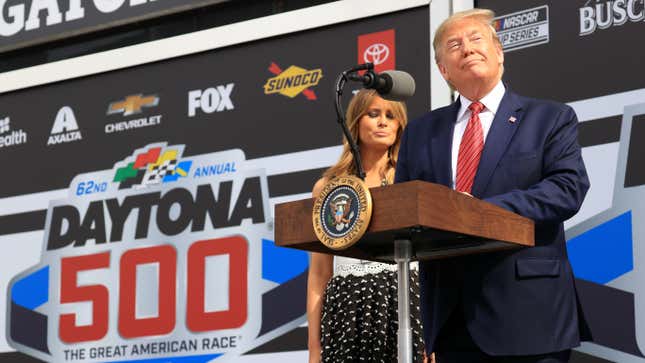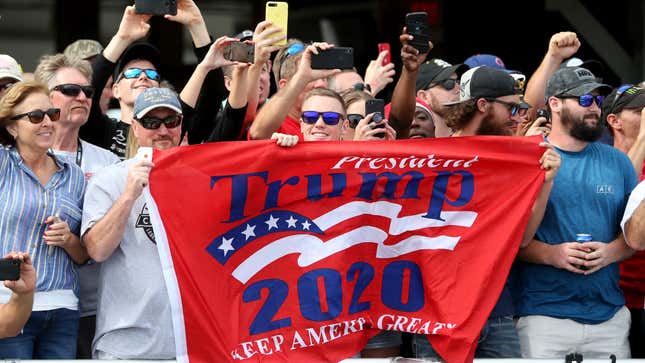
On Sunday, President Donald Trump gave the command to the “gentlemen” to start their engines at the Daytona 500. Around the same time, a story broke about a Trump administration policy in which the words given in confidential therapy sessions would be used to deport children. Despite what we may want to think, the two events are distinctly related. One is a tacit endorsement of the other.
Sports are, of course, deeply political. They always have been, and forms of racing in particular have been since at least the rise of the ancient Athenian Miltiades, who in the late 6th Century BCE used the platform afforded to him by his father’s success as a chariot racer to become a general. NASCAR knows this, too, and has spent the last 50 years letting various presidents and presidential candidates use its biggest races as a platform for official visits and campaign rallies.
But when these events occur, any and all complaints about what the sport is actually endorsing are met by bleats of deference to the office, a celebration of the mere existence of a president rather than the person in or seeking the office themselves. Pole sitter Ricky Stenhouse Jr. celebrated the visit as a strong showing of “how much this race means to everybody,” in a conversation with the Associated Press’s Jenna Fryer. Track executive Chip Wile, meanwhile, was “honored that the president of the United States has chosen to experience the pageantry and excitement” of the 500. Joey Logano added, in the way that people do when they’re trying to convince others of their cultural relevancy, that “whether you support him or not, it doesn’t matter. It shows...how big our sport really is.”
Fans knew better. Excitement for the visit ran deep among his supporters in the auto racing world, both in person and on social media. In another article for the AP by Fryer, a variety of supporters voiced their enthusiasm for what they viewed as a campaign visit, including one who brought a life-sized mannequin of Trump to the track. Supporters knew the visit was an intentional play to the base, effectively holding the race’s crowd as a personal rally separate from the race itself.

It was just another chapter in the long, questionable history of NASCAR’s relationship with political endorsement. The series is organized as just one business, owned by the family of late founder Bill France Sr., and, outside of revenue-sharing deals that go through tracks, has no financial obligation to any other powers within the sport. The arrangement fundamentally means that the family can utilize the sport’s name in any political machination they see fit.
Since 1968, this is something it has happily done.
For Bill France, Sr., it was the segregationist George Wallace. France had been a supporter since Wallace campaigned for the track that would become Talladega Superspeedway to be built within Alabama, the state he governed. During his 1968 Presidential campaign, he visited the Southern 500 (which was, at the time, still arguably the largest event in stock car racing), where France explicitly endorsed him. In 1972, he left NASCAR entirely, and shortly afterward took a job running Wallace’s presidential campaign. In the four years in between, he forced a union out of existence by allowing lower-level teams run as the top-level series during a massive safety-related driver boycott at the first race at the Talladega Superspeedway Wallace helped create. Effectively, it would be his second time busting a driver’s union.
The Bill France, Jr., era that followed was dotted with occasional visits, most famously a 1984 visit by then-president Ronald Reagan, the first sitting president to attend a NASCAR race. (Carter, who once worked as a ticket-taker at Atlanta, only visited on the 1976 campaign trail and invited drivers to the White House.) Reagan’s trip, too, was a naked attempt to court campaign interest in a re-election year, but Reagan stayed throughout the race and spoke with winner Richard Petty after the event. This event was explicitly a campaign stop on a trip with no other purpose.
The NASCAR Bill France, Jr. fostered had become a beacon of rose-tinted Americana by 1992, a year in which both incumbent George H.W. Bush and future president Bill Clinton attended separate races. While this was on the surface the only real election cycle to feature a bipartisan attempt to leverage NASCAR crowds, the reactions could not have been more different. While Bush’s visit went off without fanfare, Clinton’s was a predictable disaster, as the crowd at that time had surely serious concerns about good ol’ boy Clinton’s “draft dodger” status. The France family (which at the time also owned both Daytona and Darlington through a separate company) had made the venue available to Clinton, but the realities of the sport meant that, even in a straightforward appearance, Clinton was heavily booed.
(If you’r curious, yes Obama and Michelle got booed when they filled in as grand marshals in Miami in 2012.)
The France family (which at the time also owned both Daytona and Darlington through a separate company) had made the avenue available to Clinton, but the realities of the sport meant that, even in a straightforward appearance paling in comparison to those made by Wallace and Reagan, they were not offered an equal platform.
A visit to the Daytona 500 by George W. Bush in 2004 served the same purpose as his father’s in 1992. It marked Bush’s second visit to Daytona, something he also did during the July race in his first election campaign in 2000. This, at least, was nakedly seen as a campaign stop, with an AP article from the era noting that he was simply looking to court the type of voters that NASCAR stereotypically represented. Unlike the endorsements of Wallace and Trump, these visits at least carried some degree of subtlety. Bill France Jr. was still allowing NASCAR to be used as a campaign vehicle, but the family’s clear support of the candidates in question was not on public display.
Brian France, however, returned to the family tradition of political cheerleading. He endorsed Trump outright in March of 2016, at the time bringing a few drivers who shared their endorsements with him in what, despite France’s denials, was indistinguishable from a move on behalf of NASCAR on an organizational level. He later said that the endorsement was explicitly personal, but Trump would still say that the endorsement was on behalf of NASCAR for the rest of the election cycle. France, who is reportedly a friend of Trump’s son, Donald Jr., stepped down as the most powerful man in NASCAR after receiving a DUI during a NASCAR race weekend.
Sunday marked his first publicly-known visit to a NASCAR race since the arrest.
France’s endorsement of Trump was not subtle, and it certainly cannot be said that he did not know where the man’s presidency would be going. France made the choice just a few months after NASCAR itself cancelled plans to hold its banquets for two lower-level national series at a Trump property because of remarks he had made about immigration, and a single day after Trump refused to reject the support of the KKK and direct endorsement of David Duke. France, who once proudly told a crowd that he was the man most responsible for NASCAR’s diversity efforts, knew exactly what he was sacrificing with his endorsement.
Today, the France family knows exactly what they’re endorsing when they dedicate the majority of the Daytona 500's pre-race ceremonies, something so consistently massive that Daytona’s paper of record calls it the race’s “Opening act,” to a sitting president. No matter how aggressively they try to separate the sport from the personal endorsement of Brian France, their long-standing use of the sport and their properties to offer platforms to politicians like Trump is difficult to ignore, and the lengthy time given to Trump on Sunday was rivaled only by the windows given to Reagan and George Wallace, both of whom offered the sport itself more time than the window they were given for their campaign events. This is an intentional act, and one in intentional support of someone who has been a problem for the series and its business operations since 2016.
The France family greeted Trump at the airport, apparently as a group, before he made his way to the track. They own Daytona Speedway directly through NASCAR, after purchasing the once-publicly-traded International Speedway Corporation, a track holding group that they also owned until the 2019 merger. At any point, their ownership group could have superseded any decisions made by track executive Chip Wile, and they could have reduced the nearly half hour of pre-race ceremony committed to Trump’s visit. Instead, they participated directly.
The pomp and circumstance of this visit is not particularly complicated. Trump has been testing out other major sporting events since getting booed at the World Series. He’s been rarely seen at public events before the beginning of this most recent election cycle, and Daytona looked like safe territory. He wanted an easy win, and Daytona International Speedway was willing to give him their crowd and platform to do it. By the time he left, many hours before the race was formally delayed to the next day, he had already gotten what he wanted. While fans, who sold the race out this year just as they did last year without a presidential visit, waited for hours to get through historically-stringent security checkpoints and sit through six hours of rain delays, Trump rolled in minutes before his appearance, successfully used NASCAR’s platform to remind his base of his message, and went home before he could get his shoes wet.
Bill France was heavily criticized for offering an actual endorsement when he was the actual president of NASCAR, but this weekend saw his family’s combined resources give Trump much more. And they did it all without having to admit that they were offering anything out of the ordinary. Trump is a sitting president after all. This wasn’t nominally any different than getting hosted by the College Football Playoffs. Instead of having to quell sponsor threats and drivers saying their endorsements were a Curb Your Enthusiasm-style mistake, the Frances were able to stay out of the limelight entirely, even as they personally greeted Trump when he arrived.
Deny all they want, though, and this was a deeply political machination, as NASCAR’s campaign work always has been. No surprise that you might find a picture of a young(er) Bob Dole on the campaign trail in 1976, holding up the promo poster for the Southern 500 covered in the stars and bars. The only difference was back then campaigning politicians were more likely to say the quiet part loud.